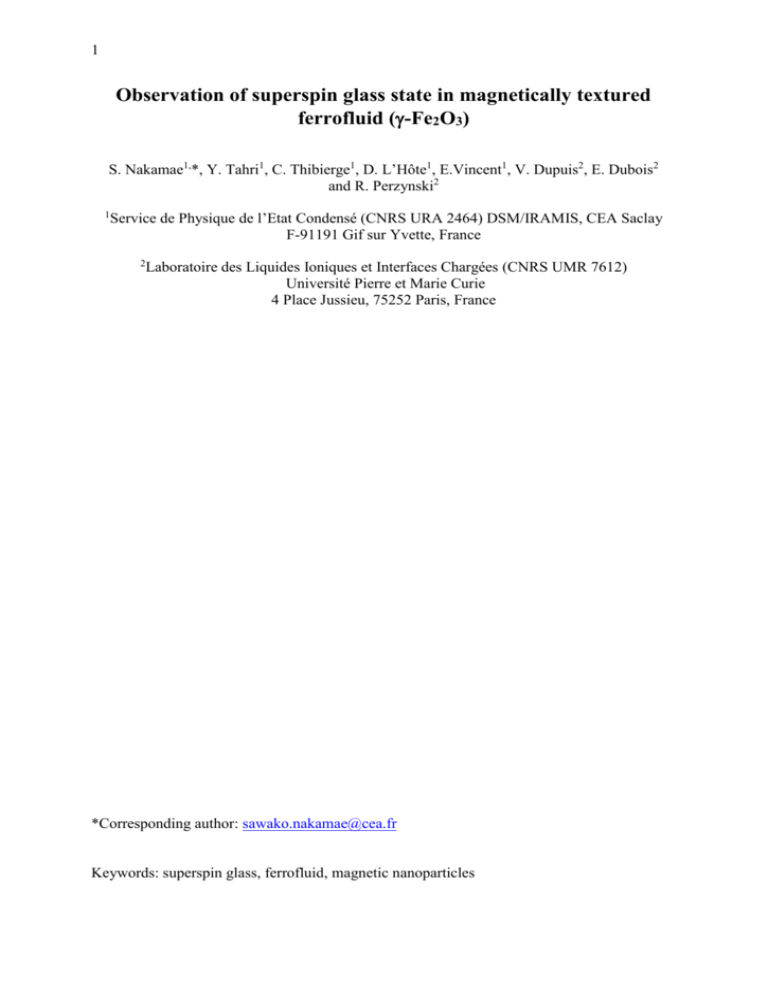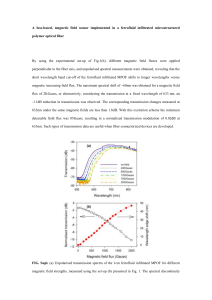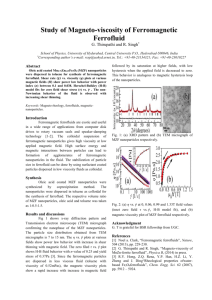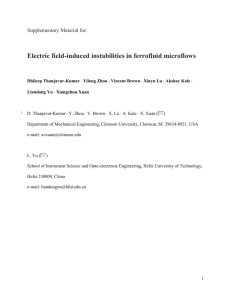Observation of superspin glass state in magnetically textured
advertisement

1
Observation of superspin glass state in magnetically textured
ferrofluid (-Fe2O3)
S. Nakamae1,*, Y. Tahri1, C. Thibierge1, D. L’Hôte1, E.Vincent1, V. Dupuis2, E. Dubois2
and R. Perzynski2
1
Service de Physique de l’Etat Condensé (CNRS URA 2464) DSM/IRAMIS, CEA Saclay
F-91191 Gif sur Yvette, France
2
Laboratoire des Liquides Ioniques et Interfaces Chargées (CNRS UMR 7612)
Université Pierre et Marie Curie
4 Place Jussieu, 75252 Paris, France
*Corresponding author: sawako.nakamae@cea.fr
Keywords: superspin glass, ferrofluid, magnetic nanoparticles
2
ABSTRACT:
Magnetic properties in a magnetically textured ferrofluid made out of interacting maghemite
(-Fe2O3) nanoparticles suspended in glycerin have been investigated. Despite the loss of
uniform distribution of anisotropy axes, a superspin glass state exists at low temperature in a
concentrated, textured ferrofluid as in the case of its non-textured counterpart. The onset of
superspin glass state was verified from the sample’s AC susceptibility. The influence of the
anisotropy axis orientation on the aging behavior in the glassy states is also discussed.
3
I. INTRODUCTION
Magnetic nanoparticles have been widely used in many areas of technological applications
ranging from non-volatile information storage1, to biomedicine2. Our understanding of the
underlying physics of nanoparticle magnetic behavior is, however, quite limited. One example
is found in concentrated frozen ferrofluids where magnetic nanoparticles interact via random
long range dipolar interactions. These systems often exhibit magnetization dynamics that are
analogous to that of atomic spin-glasses. Owing to the large magnetic moments of individual
nanoparticles, these are now considered a new class of system called “superspin glass”3.
Previous investigations on concentrated frozen ferrofluids have unveiled some of the key
magnetic features of a glassy-phase including non trivial aging and memory effects at low
temperatures4.
In magnetically textured media, the positions of particles are frozen, either in solid matrices or
by freezing the liquid carrier in a strong applied magnetic field, with all nanoparticles’
magnetic easy-axes oriented in the field direction. Therefore, the distribution of anisotropy
axes is no longer random. The effect of anisotropy axis alignment on the physical properties
of nanoparticle assemblies have been studied both theoretically and experimentally in their
superparamagnetic state5-10. However, little is known on the consequences at low
temperatures in the concentrated regime. For example, to the best of our knowledge there has
been no experimental evidence of a superspin glass state of a magnetically textured frozen
ferrofluid which, if it exists, should behave differently from that of non-textured ones.
Recently, we have studied superspin glass dynamics in a randomly oriented frozen ferrofluid
made of maghemite (-Fe2O3) nanoparticles11 dispersed in glycerin. The results show that the
superspin glass dynamics (aging process) closely resembles that of Heisenberg-like atomic
spin glasses. In this study we have used the same maghemite-glycerin ferrofluid and aligned
4
the easy magnetization axis of individual nanoparticles by freezing the liquid matrix in the
presence of high magnetic fields (H > 1.5T). As the anisotropy-axis alignment is the only
difference between these studies, the direct comparison between the two should elucidate the
influence of, and only of, the anisotropy axis orientation to their magnetic behavior in the outof-equilibrium (superspin glass) states. In addition, if a superspin glass state persists in the
magnetically textured frozen ferrofluid, a strong uni-axial anisotropy should bring the system
toward the Ising(-like) superspin glass limit. One of the most troubling questions in spin-glass
physics is the slow growth of a dynamical correlation length in the glass phase and its
dependence on spin anisotropy. We comment on this issue at the end of this paper.
II. EXPERIMENT
The investigated ferrofluids are constituted of maghemite nanoparticles which are chemically
synthesized in water12. The particles’ diameters are distributed according to a log-normal law
with a median value of 8.6 nm (corresponding to a superspin moment of 104B) and a
polydispersity of 0.23. Owing to the surface charges, nanoparticles are dispersed in glycerin
with a volume fraction (of solid) of 15%. A good physico-chemical control ensures the
absence of aggregates and chains. More details on the preparation and characterization
techniques can be found elsewhere.12
Approximately 1.5L of ferrofluid was inserted and hermetically sealed in a glass capillary
with 1mm inner diameter. The magnetization and magnetic susceptibility measurements were
performed using a commercial SQUID magnetometer. A sufficiently large magnetic energy at
high temperature (above the fusion temperature of glycerin) is needed to physically rotate and
align (on average) particles’ anisotropy axes along the applied field direction. The rotation
and the alignment of nanoparticles in the fluid matrix can be directly measured by the
birefringence technique.11,13 An axis-alignment at H > 5 kOe at room temperature has been
5
observed in a concentrated ferrofluid similar to ours13. In our experiments, H = 15 (and 30
kOe) was applied at 300K for over one hour. With H still present, the fluid was cooled down
to 150K, much below the freezing temperature of glycerin (~200K). The high field was then
removed and DC magnetization was measured as a function of temperature with 1Oe applied
field. As can be seen from Figure 1a, the magnetization curves obtained on the sample aligned
under 15 and 30 kOe both show superparamagnetic behavior at high temperatures (T > 70 K).
Furthermore, the two curves superimpose over one another within the experimental
uncertainty, indicating uniaxial anisotropy orientation. All data presented on the textured
sample hereafter were taken on the ferrofluid aligned at 30 kOe.
III. RESULTS AND DISCUSSION
In order to probe the low temperature superspin glass transition in our textured ferrofluid,
Zero-Field Cooled (ZFC)/Field Cooled (FC) DC magnetization (1 Oe probing field) as well as
AC susceptibilities (frequency range = 0.04~8Hz, 1 Oe excitation field) were measured as
functions of temperature. In Figure 1b, we compare the ZFC/FC curves of the textured
ferrofluid to that of the same sample before texturing. Notice that for temperature above 200K,
where glycerin starts to melt, M(T) of the textured ferrofluid approaches that of the nontextured sample, indicating that superspins are indeed frozen in a chosen direction at lower
temperatures. In the case of ‘non-interacting’ superparamagnetic particles, M//, magnetization
in the applied field direction of a non-textured ferrofluid at high T follows the well-known
Langevin behavior14, M//()=Ms[coth()-1/] which equals N2H/3VkBT in the weak field limit,
where Ms = the saturation magnetization of the magnetic material and = /kBT (VpMs is
the magnetic moment of each particle). When particle axes are fixed into a preferred
orientation in the presence of an applied field, magnetization is no longer given by the
Langevin law. Cregg and Bessais have given a general integral expression for the
6
magnetization of a textured superparamagnetic system15. In the extreme limit where
anisotropy energy Ea → ∞ and without interactions, M// = Ms tanh() which becomes
N2H/VkBT in the weak field limit16. The anisotropy energy of our maghemite nanoparticles,
Ea/kB = 2x300K17 is much greater than the magnetic energy /T ~ 1 K (for H in the order of
1G). As seen Figure 1b, M(T) of the textured frozen ferrofluid becomes slightly more than
three times larger than that of non-textured fluid in their respective superparamagnetic states.
The separation between the FC/ZFC curves appears at 70K for both the textured and the nontextured systems (Figures 1a&b). In order to distinguish superparamagnetic blocking behavior
(in which a FC/ZFC curve separation is also observed) from superspin-glass behavior, one
can analyze the frequency () dependent shift of the temperature where the real part of the
AC susceptibility ’peak displays a maximum value, Tg() (Figure 2a). If the textured frozen
ferrofluid is a simple superparamagnet, Tg() can be fit to the Arrhenius law:
1 o exp Ea / k BTg () , to recover o, the attempt time for a coherent rotation of all
atomic spins belonging to one particle (superspin flip). o is in the order of 10-9~10-10s for the
types of magnetic particles used in our study. We find that the fit to the Arrhenius law gives
an unphysical value of o ~10-19sec (Figure 2c) signaling that the system is not a simple
superparamagnet. On the other hand, a critical law indicates the existence of a second order
phase transition (divergence of a correlation length) toward a disordered state18.
1
Tg ( ) Tg
0*
Tg
z
(1),
Our data can be fitted (Figure 2d) with a plausible critical exponent value, z= 8.5±0.3 and
o* = 1±0.5 sec. These values are comparable to those found in the non-textured ferrofluid11:
z≈ 7 and o* ≈ 5 sec. We notice that o* values are a few orders of magnitude larger than
7
the previously stated o ~ 10-9~10sec. The discrepancy can be easily reconciled by considering
the anisotropy barrier of individual particles which acts to slow down the ‘superspin flip’
attempt time with decreasing temperature: namely, o*(T)~oexp{Ea/kBT} with o ~10-9 s.
Therefore, at Tg = 70K, the corresponding o* of a ‘superspin flip’ time reaches the order of
microseconds. Thus, it appears that the superspin glass transition survives in the textured
frozen ferrofluid and with a surprisingly similar onset temperature found in a non-textured
sample. The critical exponent, on the other hand, is found to be slightly higher than its nontextured counterpart. It may be worth noting that in atomic spin glasses, the observed critical
exponents are larger in Ising spin glasses than in Heisenberg-like spin glasses19.
To elucidate the magnetic texturing effect on the superspin glass dynamics, we have
performed ZFCM measurements to extract the growing number of correlated superspins. This
method has been used successfully in atomic spin-glasses20, 21 and lately in a non-textured
superspin glass11. In the ZFCM approach, the Zeeman energy (EZ(H)) -coupling to many
subsets of correlated (super)spins with a typical size of Ns- is obtained from the magnetization
relaxation behavior. EZ(H) depends on both the applied field and on the ‘age’ of the system
(and thus Ns). For detailed descriptions on the experimental procedure and its associated
analytical approach, readers are asked to refer to our previous work.11,
21
Once EZ(H) is
determined, Ns can be extracted knowing that EZ(H) = MNsH where MNs is the magnetization
of Ns correlated (super)spins. The exact form of EZ(Ns) is known to depend on the spin
anisotropy nature19. In the case of Ising-spin glasses with a relatively small Ns, it tends to
grow as EZ(H) = √NsμH. In the case of Heisenberg-like spins with a macroscopically large Ns,
EZ = NsFCH2 is observed with FC being the field cooled susceptibility per (super)spin. The
appropriate expression of EZ is far from obvious and it is often chosen based on the
experimental observation; i.e., whether EZ depends linearly or quadratically on H19.
8
Our previous ZFCM experiments performed on non-textured maghemite ferrofluid exhibited
closer to a quadratic dependence on H, and the results were analyzed based on Heisenbergspin glass model accordingly11. The Zeeman energy is also found to depend on the system’s
‘age’ here, further lending support to the persistence of low temperature superspin glass state
in a textured frozen ferrofluid. Interestingly, in a stark contrast to the non-textured counterpart,
our preliminary ZFCM results on the textured ferrofluid show a clear linear dependence on H
(not shown). A shift from a quadratic to linear field dependence of EZ is indeed expected in
the Ising (super)spin glass limit. Full analysis and comparison with randomly-oriented
Heisenberg like superspin glass will be given elsewhere.
IV. SUMMARY
In summary, the magnetic properties of a concentrated and textured maghemite frozen
ferrofluid in glycerin were measured. It has been found that anisotropy-axis alignment among
nanoparticles leads to largely enhanced magnetization in the whole temperature range
explored. Meanwhile, the superparamagnetic to superspin glass state transition is preserved
with similar onset parameters as those found in the non-textured case. Additionally, the outof-equilibrium dynamics in the superspin glass state in textured ferrofluid appears to evolve
toward that of Ising (super)spin glass.
9
REFERENCES:
1
Q. A. Pankhurst, J. Phys D: Appl. Phys 36 R167 (2003)
2
C. B. Murray et al., Mater. Res. Soc. Bull. 26 985 (2001)
3
P. E. Jonsson, Adv. Chem. Phys. 128 191 (2004)
4
See D. Parker et al., Phys. Rev. B 77 104428 (2008) and M. Sasaki et al., Phys. Rev. B 71
104405 (2005), for example.
5
J. L. Dormann et al., Adv. Chem. Phys. 98 283 (1997)
6
M. Hanson et al., J. Phys.: Cond. Mat. 5 725 (1993)
7
F. Bentivegna et al., J. Appl. Phys. 83 7776 (1998)
8
Yu. L. Raikher, J. Magn. Magn. Mater.39 11 (1983)
9
I. Hrianca, Physica B 403, 1831 (2008)
10
Hasmonay et al, Eur. Phys. J. B 5 859 (1998).
11
E. Wandersman et al., Cond-mat/arXiv:0806.0564 (2008), submitted Euro. Phys. Lett.
12
B. Berkowski (ed) Magnetic Fluids and Application Handbook, Begell House NY (1996).
13
G. Mériguet et al., J. Phys.: Cond. Mat. 18 10119 (2006)
14
R. W. Chantrell, et al. J. Magn. Magn. Mater. 53 1999 (1985)
15
P. J. Cregg and L. Bessais, J. Magn. Magn. Mater. 203 265 (1999)
16
P. J. Cregg and L. Bessais, J. Magn. Magn. Mater. 202 554 (1999) and references within
17
F. GAZEAU, et al., J. Mag. Mag. Mat . 186 175 (1998).
18
C. Dijurberg et al., Phys. Rev. Lett. 79 5154 (1997)
19
F. Bert et al., Phys. Rev. Lett. 92 167203 (2004)
20
E. Vincent et al., Phys.Rev.B 52, 1050 (1995)
21
Y.G. Joh et al., Phys. Rev. Lett. 82, 438 (1999)
10
FIG 1: DC Magnetization (M) vs. Temperature of maghemite ferrofluid under a probing field
of 1 Oe. a) Comparison between M(T) measured after the sample had been aligned at 15 kOe
and at 30 kOe. b) M(T) of textured and non-textured ferrofluid. Note that both measurements
were taken on the same ferrofluid sample, one (non-textured) prior and the other (textured)
after the sample was exposed to a strong field to align the anisotropy axes of nanoparticles.
11
FIG 2: AC susceptibility of textured ferrofluid vs. Temperature at various excitation
frequencies (in CGS). a) In phase (real component) and b) Out of phase (imaginary
component) of AC susceptibility. In both components, the peak position shifts toward higher
temperatures with increasing frequency (). Evolution of the frequency dependent peak
temperature in the real-part of AC susceptibility, ’(), fit to c) Arrhenius law and d) Critical
law.





